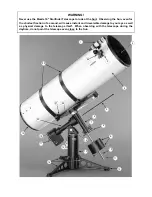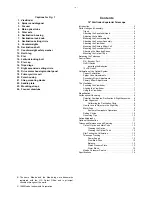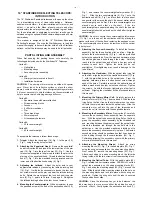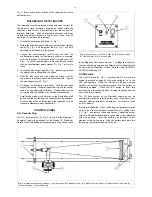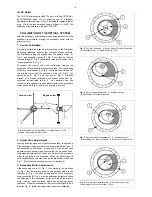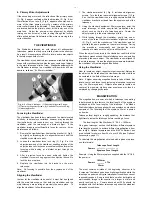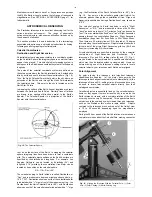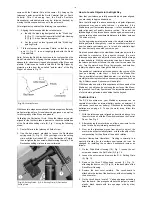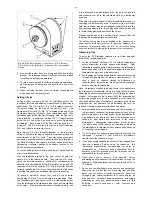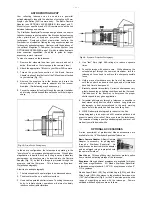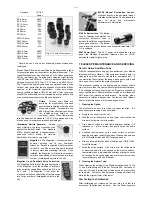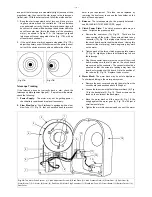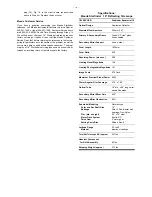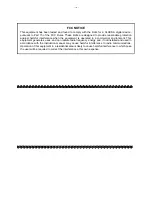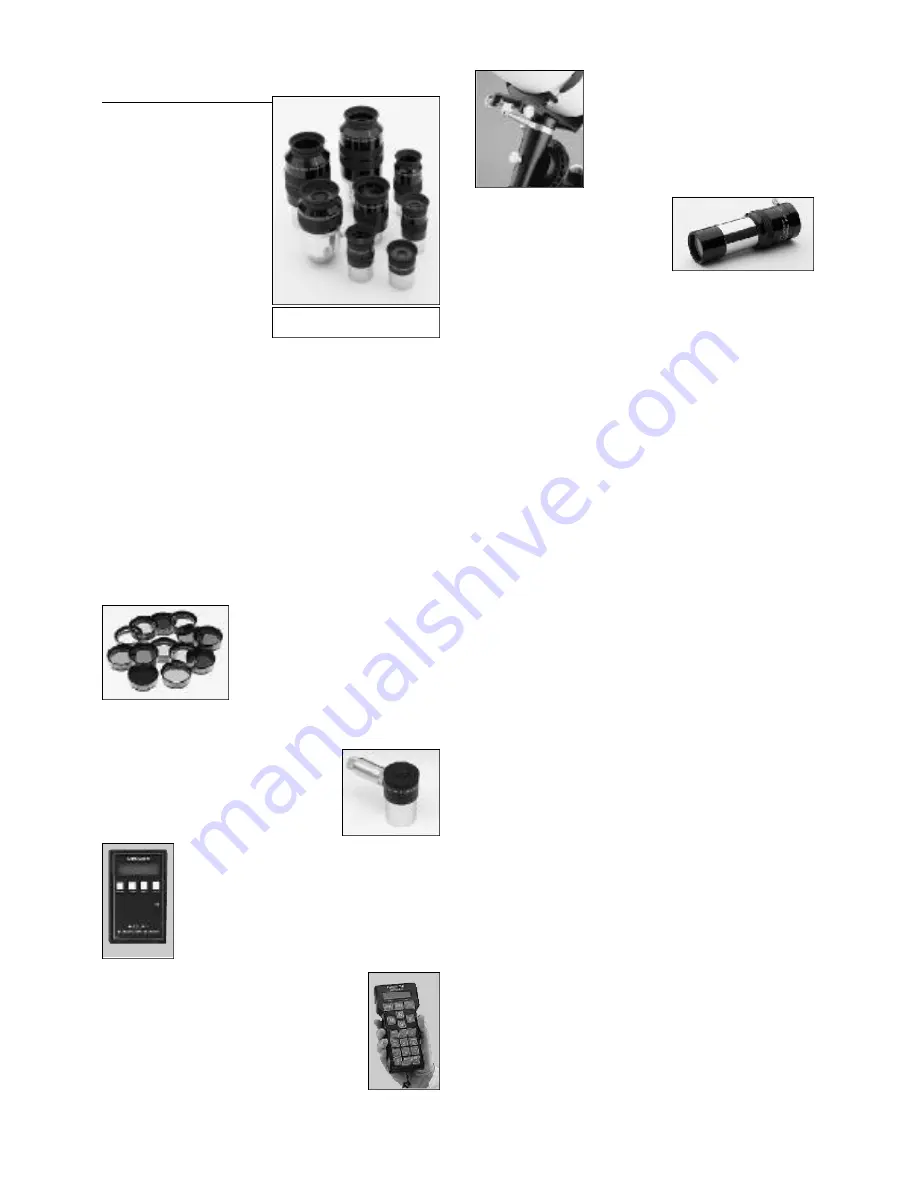
- 12 -
Eyepiece
16" f/4.5
Power
SP 6.4mm
286X*
SP 9.7mm
187X
SP 12.4mm
148X
SP 15mm
122X
SP 20mm
92X
SP 26mm
70X
SP 32mm
57X
SWA 13.8mm
133X
SWA 18mm
102X
SWA 24.5mm
75X
SWA 32mm
57X
UWA 4.7mm
389X*
UWA 6.7mm
273X*
UWA 8.8mm
208X
UWA 14mm
131X
* Should be used only under extremely steady atmospheric
conditions.
Meade Super Plössl and Super Wide Angle Eyepieces are ideal
for general-purpose astronomical or terrestrial observing. The
typical Starfinder user may wish to add 2 or 3 of these eyepieces
to his or her telescope. An introductory selection might include
the SP9.7mm and SP15mm. The more advanced observer will
perhaps select the SP 9.7mm, SP 12.4mm, and SWA 18mm.
The Super Wide Angle Eyepiece series yields extremely wide
fields of view, perfect for the examination of star fields, diffuse
nebulae, or for terrestrial applications. Under very steady
seeing conditions Meade UWA 4.7mm and 6.7mm eyepieces
present the widest fields of view obtainable at high powers and
are excellent eyepieces for the Moon and planets.
F i l t e r s :
Thirteen color filters are
available for significantly increased
contrast and resolution of detail on the
Moon and planets. For example, the
#80A (blue) filter effectively enhances
the reddish-colored detail on the
surface of Jupiter. These filters thread
into the barrels of all standard 1.25" O.D. eyepieces and may
also be used for eyepiece projection photography.
Illuminated Reticle Eyepiece:
Permits
easy visibility of guiding crosslines even
against the darkest skies. The standard
# 7 0 2 A double-crossline, phosphorescent-
enhanced reticle allows for variable
illumination from faint to very bright.
Magellan I: The Magellan I accessory adds a
powerful pointing tool to your Starfinder
telescope. Encoders supplied with this product
for the R.A. and Dec. axis can be easily installed
in factory machined mounting features. Once
installed, the Magellan I will allow the electronic
selection and pointing of the telescope at a large
number of catalogued objects in the sky.
Magellan II and Dual-Axis Drive Correction:
The Magellan II offers all of the pointing features
of the Magellan I with the addition of dual-axis
drive correction capabilities on both the R.A. and
Dec. axis. The Magellan II will allow the
electronic selection and pointing of the telescope
at a large number of catalogued objects in the
sky.
#65RS Manual Declination Control:
Attaches directly to the equatorial mount,
this Manual Declination Control allows the
user
to
make
fine
micrometric
adjustments in Declination.
#140 2x Barlow Lens: The Barlow
Lens, or Telenegative Amplifier, is a
convenient accessory used to
increase the effective magnification
of any given eyepiece. The Barlow
Lens is inserted into the focuser and accepts all standard 1.25"
O.D. eyepieces.
#607 Power Cord: This 25 ft. power cord allows the user to
power the Starfinder Equatorial Telescope from an 12vDC
automobile cigarette lighter plug.
TELESCOPE MAINTENANCE AND SERVICING
Care Of Optics And Main Tube
With the reasonable care due any fine instrument, your Meade
telescope will last a lifetime. If the eyepieces become dirty, try
cleaning them with a camel's hair brush or compressed air. If
you must wipe the surface of the lenses, do so gently with a soft
cloth so as not to scratch the protective coatings.
The aluminum coating on the primary and secondary mirrors
may last more than ten years without significant deterioration.
(The coatings will last a shorter period if regularly exposed to
salty or polluted air.) Minor blemishes, scratches, or streaks will
NOT impair the telescope's performance. Re-coating, when
necessary, is relatively inexpensive. Contact your local Meade
dealer for information on mirror re-coating services.
1. Cleaning the Optics:
The most common error is to clean the optics too often. If it
does become necessary, clean as follows:
a. Remove the mirror from its cell.
b. With the mirror resting face up on a towel, run a continuous
stream of cold water onto its surface.
c.
Dip a wad of cotton in a mild liquid detergent solution (1/2
teaspoon to 1 pint of water) and gently swab the entire
surface.
d. Continue running water on the mirror surface to prevent
beading and make ready three wads of cotton and a solution
of 50% distilled water and 50% isopropyl alcohol.
e. Dip a cotton wad into the alcohol solution and, ONLY NOW,
turn off the water.
f.
Swab the entire surface. Do not turn over the cotton wads
or dissolved skin oils may deposit on the mirror's surface.
Immediately take a dry swab and continue wiping the entire
surface gently. Keep changing wads until the mirror surface
is completely dry and free of streaks.
2. Cleaning the Optical Tube:
When cleaning the outside of the Starfinder optical tube (4, Fig
1), use a mild detergent, (Pine-Sol, Formula 409, Fantastic, or
oil soap). Oil soap is preferred as it also acts as a preservative
for the paint. Solvent or alcohol based cleaning solutions will
diminish the original luster of the paint.
Star Testing the Collimation
After collimating your telescope, the next step is to test the
accuracy of the alignment on a star. Use the 25mm eyepiece
Fig. 17: Series 4000 eyepieces.


